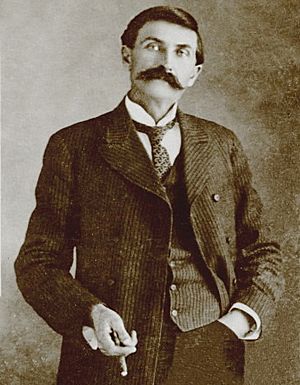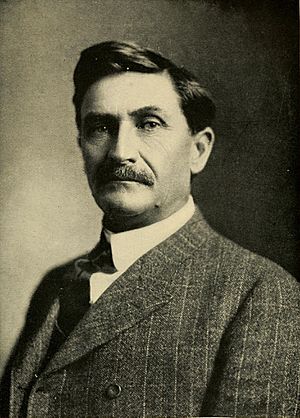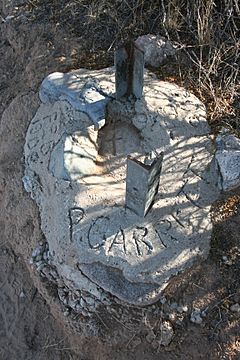Pat Garrett facts for kids
Quick facts for kids
Pat Garrett
|
|
|---|---|

Garrett c. 1903
|
|
| Born |
Patrick Floyd Jarvis Garrett
June 5, 1850 |
| Died | February 29, 1908 (aged 57) |
| Cause of death | Gunshot wound |
| Resting place |
|
| Known for | Killing William H. Bonney (Billy the Kid) |
| Spouse(s) |
|
| Children | 8 |
| Signature | |
Patrick Floyd Jarvis Garrett (born June 5, 1850 – died February 29, 1908) was a famous lawman from the American Old West. He is best known for finding and killing the outlaw Billy the Kid. Garrett also worked as a bartender and a customs agent. He served as the sheriff of Lincoln County, New Mexico and Doña Ana County, New Mexico.
Contents
Pat Garrett's Early Life
Patrick Floyd Jarvis Garrett was born on June 5, 1850. His birthplace was Chambers County, Alabama. He was the second of five children. His parents were John Lumpkin Garrett and Elizabeth Ann Jarvis.
When Pat was three, his family moved to Claiborne Parish, Louisiana. They bought a large farm. However, the American Civil War caused his family to lose their money.
His mother died in 1867 when Pat was 16. His father died the next year. The children were left with a farm that had many debts. Relatives took care of the children. When he was 18, Garrett left Louisiana on January 25, 1869. He headed west.
Becoming a Buffalo Hunter
We don't know much about Garrett's life for the next seven years. By 1876, he was in Texas. He was hunting buffalo. During this time, Garrett killed his first person. It was another buffalo hunter named Joe Briscoe. Garrett turned himself in to the police. But they decided not to charge him.
When there were fewer buffalo to hunt, Garrett left Texas. He rode to the New Mexico Territory. He arrived at Fort Sumner, New Mexico. There, he found work as a bartender. Later, he became a cowboy for Pedro Menard "Pete" Maxwell.
Garrett's Family Life
Garrett's first wife was Juanita Martinez. She died only 15 days after they got married.
On January 14, 1880, Garrett married Apolinaria Gutierrez. Between 1881 and 1905, they had eight children. Their names were Ida, Dudley, Elizabeth, Annie, Patrick, Pauline, Oscar, and Jarvis.
The Hunt for Billy the Kid
Billy the Kid, also known as William Henry Bonney Jr., was wanted for murder. This happened after the Lincoln County War.
On November 2, 1880, Garrett was chosen as the sheriff of Lincoln County, New Mexico. He won against the current sheriff, George Kimball. Even though his term started in January 1881, Sheriff Kimball made him a deputy right away. Garrett also became a deputy U.S. Marshal. This allowed him to chase Billy the Kid across different states.
Garrett and his team searched the Dedrick ranch on November 30, 1880. They thought Billy the Kid would be there. But they only caught John Joshua Webb and George Davis. Garrett gave them to another sheriff. Then he moved to Puerto de Luna, New Mexico. There, a local tough guy named Mariano Leiva started a fight with Garrett. Leiva was shot in the shoulder.
On December 19, 1880, Billy the Kid and his friends rode into Fort Sumner. Garrett and his team were waiting. Garrett's men thought Tom O'Folliard was Billy the Kid. They shot and killed O'Folliard. Billy and the others got away safely.
Three days later, Garrett's team found Billy and his friends at Stinking Springs. They killed Charlie Bowdre and captured the others. On April 15, 1881, Billy the Kid was sentenced to be hanged. But he escaped 13 days later. He killed two deputies during his escape.
On July 14, 1881, Garrett went to Fort Sumner. He asked a friend of Billy the Kid's where he was. He learned that Billy was staying with a mutual friend, Pedro Menard "Pete" Maxwell. Around midnight, Garrett went to Maxwell's house. Billy the Kid was sleeping in another part of the house. He woke up and went into Maxwell's bedroom. Garrett was standing in the shadows. Billy the Kid did not recognize the man in the dark. He asked, "¿Quién es?" ("Who is it?") several times. Garrett answered by shooting him twice. The first shot hit Billy the Kid in the chest, near his heart. The second shot missed. Billy the Kid died.
Writing About Billy the Kid
Pat Garrett helped write a book called The Authentic Life of Billy, the Kid. He wrote it with Ash Upson. For many years, this book was considered the most accurate story.
After Billy the Kid's death, writers quickly made him a folk hero. They often made Garrett seem like a villain. Garrett's book had some mistakes. But it was the main source for most books about Billy the Kid until the 1960s. When it first came out, the book did not sell well. But later, original copies became very rare.
Texas Ranger Service
Garrett did not run for sheriff of Lincoln County again in 1882. He moved to Texas. There, he tried to become a state senator but did not win. Garrett became a captain with the Texas Rangers for a short time. Then he returned to Roswell, New Mexico.
Garrett's Middle Years
Investing in Water Projects
Garrett found a lot of underground water in the Roswell area. On July 18, 1885, he partnered with two men. They started a company called the "Pecos Valley Irrigation and Investment Company."
Garrett worked on his water projects for several years. On January 15, 1887, he bought part of another company. But his partners got rid of him. On August 15, 1887, he started a new partnership. However, all of Garrett's efforts to build water systems failed.
By 1892, Garrett had moved his family to Uvalde, Texas. He became good friends with John Nance Garner. Garner later became a vice president of the United States. Garrett might have stayed in Uvalde. But something important happened back in New Mexico.
The Disappearance of Albert Jennings Fountain
On January 31, 1896, Colonel Albert Jennings Fountain and his eight-year-old son Henry disappeared. This happened near the White Sands area of southern New Mexico. No one ever saw them again. The mystery was never officially solved. Many people tried to find them, including Apache scouts and the Pinkertons.
In April 1896, Garrett became the sheriff of Doña Ana County. Two years later, he had enough evidence to make arrests. He asked a judge for arrest warrants for Oliver M. Lee, William McNew, Bill Carr, and James Gililland. Within hours, he arrested McNew and Carr.
On July 12, 1898, Garrett and his team faced Oliver M. Lee and James Gililland. This happened at a place called "Wildy Well." Garrett hoped to catch them while they were sleeping. But Lee and Gililland were ready for trouble. They slept on the roof of the bunkhouse. One of Garrett's deputies was shot and badly hurt by the fugitives. Garrett was also slightly hurt. Garrett stopped the fight to help his dying deputy. The deputy died on the way to Las Cruces. Lee and Gililland stayed free for eight more months. They finally turned themselves in. They were found not guilty in the Fountain killings. The charges for killing the deputy were also dropped.
Garrett's Last Capture
Garrett captured his last offender in 1899. This was a man named Norman Newman. Newman was wanted for murder in Greer County, Oklahoma. Newman was hiding at the San Augustin Ranch in New Mexico. Sheriff George Blalock from Greer County asked Garrett for help. The lawmen and Jose Espalin, one of Garrett's deputies, rode to the ranch. On October 7, 1899, Newman was killed in a gunfight.
Working for the President
On December 16, 1901, President Theodore Roosevelt chose Garrett for a job. He became the collector of customs in El Paso. He was also one of President Roosevelt's three "White House Gunfighters." The others were Bat Masterson and Ben Daniels.
Many people were upset about his appointment. But the U.S. Senate approved Garrett on January 2, 1902. Garrett's time as customs collector was difficult from the start. On May 8, 1903, he got into a public fight with an employee. The next day, both Garrett and the employee paid fines. People kept complaining about Garrett's work. But President Roosevelt supported Garrett.
To show his support, Roosevelt invited Garrett to a reunion in April 1905. Garrett brought a guest named Tom Powers. Garrett told the president that Powers was a "prominent Texas cattleman." Garrett and Powers took photos with Roosevelt. Garrett's enemies got copies of the photos. They told Roosevelt that Powers was not a cattleman. He owned a "notorious dive" in El Paso. This was the final straw for Roosevelt. He replaced Garrett on January 2, 1906.
Pat Garrett's Later Years
Money Problems
After losing his job, Garrett returned to New Mexico with his family. He was in serious financial trouble. His ranch had a large loan on it. He could not make the payments. The county sold all of Garrett's personal belongings. This was to pay off his debts. The sale brought in $650.
President Roosevelt had appointed Garrett's friend George Curry as the governor of New Mexico. Garrett met with Curry. Curry promised him a job as the superintendent of the territorial prison. This would happen once Curry became governor. But Curry's inauguration was months away. Garrett was broke. He left his family in New Mexico and went back to El Paso. He found work with a real estate company. During this time, Garrett lived with a woman. When Governor-elect Curry learned about this, he took back the job offer.
Last Conflict and Death
Pat Garrett's son, Dudley Poe Garrett, had leased his Bear Canyon Ranch. The lease was for five years with Jesse Wayne Brazel. Garrett and his son did not like it when Brazel brought in many goats. Cattlemen like Garrett did not like goats. Garrett tried to end the lease. He learned that his neighbor, W. W. "Bill" Cox, was funding Brazel's goat operation. He was even angrier when he learned that Archie Prentice "Print" Rhode was Brazel's partner.
Brazel refused to cancel the lease. So, the matter went to court. At this point, James B. Miller met with Garrett to try to solve the problem. Miller met with Brazel. Brazel agreed to cancel his lease if someone would buy his 1,200 goats. Carl Adamson, who was related to Miller, agreed to buy the goats. Just when it seemed settled, Brazel claimed he had "miscounted." He said there were actually 1,800 goats, not 1,200. Adamson refused to buy that many. But he agreed to meet with Garrett and Brazel to find a solution.
Garrett and Carl Adamson rode together from Las Cruces, New Mexico. They were in Adamson's wagon. Brazel appeared on horseback along the way. Garrett was shot and killed. But exactly who shot him is still debated. Brazel and Adamson left the body by the road. They returned to Las Cruces. Brazel turned himself in to Deputy Sheriff Felipe Lucero. More than 30 years later, Lucero claimed Brazel said, "Lock me up. I've just killed Pat Garrett!" Brazel then pointed to Adamson and said, "He saw the whole thing and knows that I shot in self-defense." Lucero arrested Brazel. He called a jury to investigate the death. Then he rode to where Garrett was killed.
Brazel's trial for Garrett's murder ended on May 4, 1909. Brazel's lawyer was Albert Bacon Fall. He later became the United States Secretary of the Interior. The only person who saw Garrett's murder, Adamson, never appeared at the trial. The trial lasted only one day. Brazel was found not guilty.
Who Killed Pat Garrett?
The official report on Garrett's death says Brazel shot Garrett. Brazel reportedly confessed, but he was found not guilty at trial. Four other people have been suggested as the killer: Adamson, Cox, Rhode, and Miller.
In a 1970 book, Glenn Shirley said Miller was the killer. Leon C. Metz wrote in his 1974 book that his research led him to believe W. W. Cox killed Garrett. But he also wrote that Garrett's family believes Carl Adamson pulled the trigger. In his 2010 book, Mark Lee Gardner suggests that Archie Prentice "Print" Rhode killed Garrett.
Garrett's Death Site
The place where Garrett died is now marked by a historical marker. It is south of U.S. Route 70. This is between Las Cruces, New Mexico and the San Augustin Pass. The marker is about 1.2 miles from where Garrett was murdered.
In 1940, his son, Jarvis Garrett, put up a monument. It is concrete around a stone with a cross carved into it. The cross is thought to be made by Garrett's mother. "P. Garrett" and the date of his killing are scratched in the concrete. The marker is in the desert. In 2020, Las Cruces planned a development that would destroy the site. An organization called Friends of Pat Garrett was formed. They want the city to save the site and marker.
Funeral and Burial
Pat Garrett was six feet five inches tall. His body was too tall for any ready-made coffins. So, a special one had to be sent from El Paso. His funeral was on March 5, 1908. He was buried next to his daughter, Ida. She had died in 1896 at age 15. Garrett's grave and the graves of his family are in the Masonic Cemetery in Las Cruces.
Pat Garrett in Movies and TV
Garrett has been a character in many films and television shows. He has been played by:
- Wallace Beery in Billy the Kid (1930)
- Wade Boteler in Billy the Kid Returns (1938)
- Brian Donlevy in Billy the Kid (1941)
- Thomas Mitchell in The Outlaw (1943)
- Charles Bickford in Four Faces West (1948)
- Monte Hale in Outcasts of the Trail (1949)
- Robert Lowery in I Shot Billy the Kid (1950)
- Frank Wilcox in The Kid from Texas (1950)
- Scott Douglas in the NBC-TV series, Omnibus (1952, 1 episode)
- James Griffith in The Law vs. Billy the Kid (1954)
- Richard Travis in the TV series, Stories of the Century (1954)
- Keith Richards in the TV series, Buffalo Bill, Jr. (1955, 1 episode)
- Bob Duncan in The Parson and the Outlaw (1957)
- John Dehner in The Left Handed Gun (1958)
- George Montgomery in Badman's Country (1958)
- Rhodes Reason in the ABC-TV series, Bronco (1958, 1 episode)
- Walter Sande in the CBS series, Wanted: Dead or Alive (1958, episode 26, "The Eager Man")
- Wayne Heffley in the ABC-TV series, Colt .45 (1959 episode entitled "Amnesty")
- Barry Sullivan (1960) in the NBC-TV series The Tall Man, co-starring Clu Gulager as Billy the Kid
- Rod Cameron in Le pistole non discutono (1964)
- Allen Case in the ABC series, The Time Tunnel (1966, 1 episode)
- Fausto Tozzi in El hombre que mató a Billy el Niño (1967)
- Glenn Corbett in Chisum (1970)
- Rod Cameron in The Last Movie (1971)
- James Coburn in Pat Garrett & Billy the Kid (1973)
- Patrick Wayne in Young Guns (1988)
- Duncan Regehr in Gore Vidal's Billy the Kid (1989)
- William Petersen in Young Guns II (1990)
- Joe Zimmerman in the TV documentary series, Unsolved History (2002, 1 episode) and in the Discovery Channel's cable documentary Discovery Quest: Billy the Kid Unmasked (2004)
- Michael Paré in Bloodrayne 2: Deliverance (2007)
- Bruce Greenwood in I'm Not There (2007)
- Michael A. Martinez in The Scarlet Worm (2011)
- Christopher Marrone in Abraham Lincoln vs. Zombies (2012)
- Ric Maddox in AMC's The American West (2016)
- Ethan Hawke in The Kid (2019)
See also
 In Spanish: Pat Garrett para niños
In Spanish: Pat Garrett para niños
- List of unsolved murders
Images for kids




